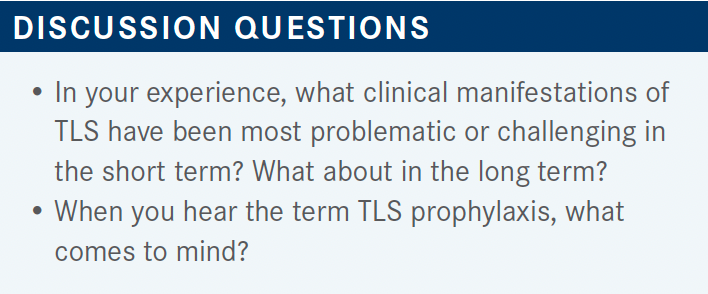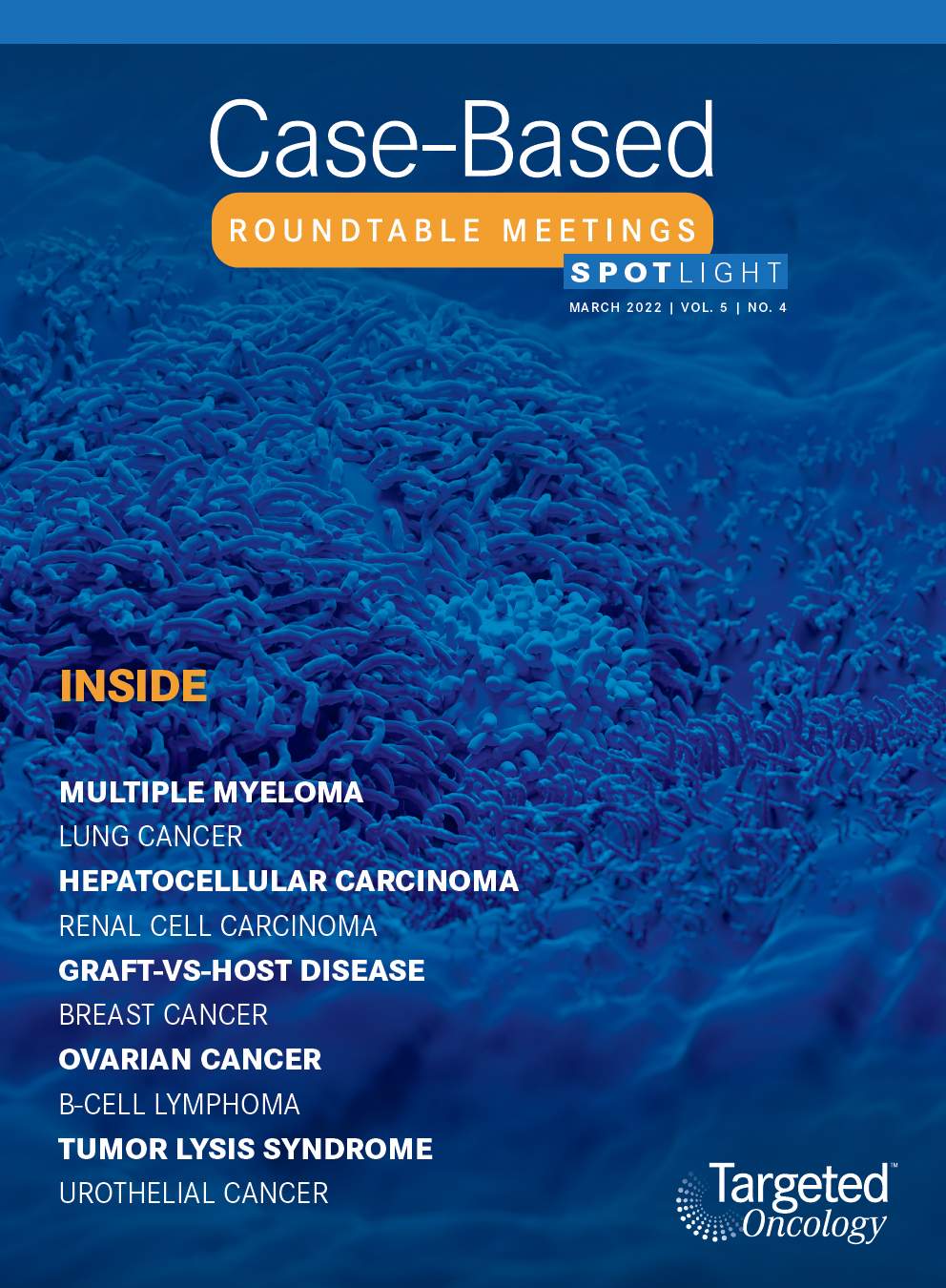Roundtable Discussion: Risk-Based Prevention of Tumor Lysis Syndrome in Hematologic Malignancies
During a Targeted Oncology case-based roundtable discussion, Javier Pinilla-Ibarz, MD, PhD, discusses risk factors and prophylactic options for tumor lysis syndrome.

Javier Pinilla-Ibarz, MD, PhD
Senior Member, Head of Lymphoma Section
Department of Malignant Hematology
Moffitt Cancer Center
USF Health
Tampa, FL


ALEGRIA: I am in Jacksonville and predominantly the population of [patients] I deal with have CLL [chronic lymphocytic leukemia] and multiple myeloma. When I’m assessing patients with CLL, I’m looking at their white blood cell count and tumor burden overall. What general history do they have? Where is the LDH [lactate dehydrogenase] already at? What are we looking at? What drugs are we going to put them on? Am I going to prophylactically start allopurinol? Do they need to be hospitalized? Are we going to do something prior to starting venetoclax [Venclexta] and reduce some of that tumor burden, and then not hospitalize after the BCL2 inhibitor? So, I just look at the overall patient and their disease burden.
PINILLA-IBARZ: I agree, sometimes it depends on the population you’re dealing with.
HUSSEIN: I definitely [consider] the type of disease and treatment. I usually check comprehensive metabolic panel and uric acid to have an idea about the baseline and assess how aggressive we need to be with treatment. I check the kidney function too.
WANG: Yes, same [here]. I’m less concerned with BTK [Bruton tyrosine kinase] inhibitors even though it can happen, but with venetoclax/obinutuzumab [Gazyva], particularly, that’s what I’m most concerned about. How much the disease burden is, what drugs we use, and whether they have any preexisting kidney dysfunctions are all factors I consider in CLL or SLL [small lymphocytic lymphoma] for TLS treatment or prophylaxis.
KHARFAN DABAJA: I think a group of patients, for instance those with CLL, have this transformation where they have these rapid proliferating tumors with masses of more than 5 cm or maybe 10 cm. They are at high risk for TLS. I think both the proliferative index and baseline serum creatinine are also important.
HURTADO: Yes, I think it depends on what kind of pathology we see and the use of the new medications, [such as] venetoclax and BTK inhibitors. Usually, I pay close attention to white blood cell count because a lot of patients get into complications because of that. Also, for the tumor burden, if I have large nodal disease that is going to be debulked rather quickly with whatever regimen I’m using, I pay close attention.
PINILLA-IBARZ: I think sometimes we believe that the [clinical manifestations] are going to happen right away, but we may forget or not realize that they may come 12 to 72 hours after initiation of these types of therapies.1 It depends on the dynamic of the treatment that we are establishing. Some of the consequences of these metabolic [disorders] could be nausea, vomiting, diarrhea, anorexia, weakness, lethargy, cardiac dysrhythmias, hematuria, seizures, muscle cramps, and syncope. Keep in mind [that older patients] may experience this after the first 24 hours.

THOMASSEN: I’ve seen some patients with increased creatinine. It was problematic in the short term for 1 patient I can think of who ended up needing dialysis because we weren’t able to correct it prior. But once he got dialysis, he was OK. That was challenging and problematic in both the short and long term.
PINILLA-IBARZ: I think you give a [good] example. Acute renal failure and the consequence of that could be an important one.
AMIN: Short term is mainly acute renal failure and hypercalcemia, and then risk of cardiac arrhythmia from that. Long term is mainly chronic renal failure or at least chronic kidney disease. Sometimes even with 1 treatment the patient ends up in rehabilitation.
I had a patient who had diffuse large B-cell lymphoma [DLBCL] with a borderline age. After the first treatment, she ended up in a hospital and had a prolonged recovery. By the time she recovered, her lymphoma was so bad that she… died because the disease was too advanced. That’s the problem with a long-term issue, if [a patient] has borderline heart function, kidney function, and is in their 80s. This is what we see in Florida, mainly.
PINILLA-IBARZ: You bring up a good point. It depends on the biology of the disease and how soon you need to retreat those patients. I have experience with some patients with CLL who you treat and they get TLS, but it takes a long time until they require therapy. But patients with lymphoma are going to come back to you soon.
PARAS: [I see] the same as what my other colleagues have said, though mainly we deal with the older population with a lot of comorbidities. The main issue is that whenever they go into renal failure from TLS, you would like to hydrate them, but then there’s a challenge that you might push them to congestive heart failure. A lot of times the renal failure reverses, but it takes longer, especially if they’re older [patients]. Sometimes if they go to congestive heart failure or renal failure, they get chronic renal failure or have a heart attack. Sometimes they don’t fully recover from the initial injury that was brought about by the chemotherapy. I’ve seen it a lot of times where they develop complications from chemotherapy and one of them is TLS.
MURTHY: When I think prophylaxis, we all think allopurinol. But something else we really think about is not necessarily prophylaxis but more like hypervigilance in terms of monitoring the patients. Essentially, it is the prophylactic measures that we take: close monitoring, hydration, monitoring the laboratory results very frequently and determining whether in-patient hospitalization is the safest thing. So I think of all those things when I hear TLS prophylaxis.
PINILLA-IBARZ: I think it’s a good point. It’s everything that comes together.
GLIGICH: I agree. Starting allopurinol early is very important. A large portion of what we tend to forget is the amount of IV [intravenous] hydration that these patients need. Usually, if they are high risk, I tend to start them anywhere from 300 mL to 500 mL an hour, because if you look at the data that’s what prevents renal disease.
One of the things that we didn’t mention or didn’t home in on in the past is about what the risk factors for TLS are. I treat a lot of DLBCL and high-risk lymphomas, and the Ki-67 score is huge for me, but you can’t focus on 1 particular point [such as] the white blood cell count, the kidney dysfunction, or the Ki-67 score. You need to take a look at the clinical picture all together, and if you’re missing 1 of these factors, you can’t put the pieces together. So I think everything is extremely crucial here.
PINILLA-IBARZ: I completely agree, and I was touching upon the fact that every patient is different. As you mentioned, you must get this global approach about these specific things. For Ki-67, we have 80% to 90% in this setting; most of the time you’re going to see a high LDH, but not always. This disease is growing fast, and as soon as you touch it, they are going to be [in a tough situation], because it depends on what you do. But I think it’s a great point.
CARTWRIGHT: I agree, too. It’s more of using judgment and weighing multiple factors [such as] the underlying comorbidities and patient’s age. Hydration and allopurinol are the first things that come to mind.
PINILLA-IBARZ: Something that always provoked me is the fact that even if we do everything sometimes we still [have problems].

NAKKA: We have the tumor factors, patient factors, and treatment-related issues that could determine if a patient is high risk or low risk. But I’m thinking that one of the unmet needs is a marker that tells us [if] the marker is high, we give prophylaxis, let’s say IV fluids or allopurinol. Or if the marker is higher, then you give IV fluids and rasburicase [Elitek] with the first treatment. We have multiple things to put together, but it’s still hit or miss.
PINILLA-IBARZ: We can do our best. I think we may be familiar with the classification of TLS in the venetoclax [treatment guide, based on absolute lymphocyte count of] less than 25, more than 25, and so on.2 I think it’s, as you all mentioned, a conglomerate of issues that must be taken on a patient-by-patient basis. Otherwise, it’s tricky.
ALEGRIA: One area that I’m still a little unsure on—and it’s an area that we’re delving into a little bit more with BCL2 inhibitors regarding multiple myeloma—what makes them potentially higher risk for TLS? Is it just the bone marrow involvement? Is it extramedullary disease? What defines them as being a higher risk when we’re using that kind of drug? I think that that’s an area that isn’t too well known.
PINILLA-IBARZ: We don’t have specific markers that will tell you what the higher risk is. That’s the reason we try to use prophylaxis.
THOMASSEN: About being hypervigilant, I think sometimes in these cases maybe we think, “Oh, it’s not going to happen,” and we put it out of our mind. Then you’re caught off-guard a little bit. So maybe taking the extra time to be super thorough in the assessment of the patient, not taking anything for granted, and making sure that the whole team is involved can prevent it.
PINILLA-IBARZ: I think it’s a good point. Once again, I think sometimes we get caught off-guard because we may not have enough monitoring capacity.

AMIN: I have used it in a patient with CLL who was getting venetoclax and had a very high tumor burden, a patient with AML [acute myeloid leukemia], and a patient with Burkitt lymphoma. I have used it both in the outpatient and inpatient setting. Usually, the dose requirement in a trial is high, maybe 2 doses or more to bring down the uric acid to the below normal level, most of the time. You’ll catch it with hydration, and allopurinol on top of that….I have never seen the drug not work, and it always has very good efficacy.
For outpatient [cases], I have no problem because I always get authorization from insurance and give it. But, inpatient, they don’t have it in the formulary, so I beg the pharmacy to do it, and it sometimes takes a few hours or a day to get it. That’s always a problem.
PARAS: I mainly treat solid tumors, but I have a few experiences. One is a patient with bulky DLBCL. Then, another had AML and I treated them with venetoclax, but the uric acid went up at treatment, though his numbers were not elevated to begin with, and he went to renal failure, so I decided to put him on rasburicase. Both did well, but I usually have intermediate or low-grade, low-risk cases.
PINILLA-IBARZ: What kind of dosing do you use? Is it the 0.2 mg/kg or the flat dose?
MURTHY: We use the flat dose, and I’ve had no issues. Frankly, the only issue that I had was getting a little pushback from pharmacy about giving it. But other than that, it is very tolerable and works fast. I’ve used it in Burkitt, AML, and ALL. I’m a believer.
PINILLA-IBARZ: Do you use 3 mg or 6 mg?
MURTHY: [I use] 6 mg.
GLIGICH: I haven’t done 3 mg because I always have problems with pharmacy. They only give me the limited dose, 1.5 mg. The patients always respond very well, and I want to call back pharmacy the following day and ask them to give me more. The uric acid levels plummet, and they do well.
HURTADO: I have used it. I never had any adverse event from it. I have used it in AML, CLL, and lymphomas as well. I think the biggest issue is I practice in a community-based public-funded institution. I think they go a lot by the guidelines. If you try to use more clinical judgment, they might [push back] if the patient is not particularly high risk. Let’s say you think that the patient already had preexisting renal disease and they might benefit from prophylaxis—they might give you some pushback. Generally, if the patient is high risk, or has AML, or something [such as] that, the pharmacy will dispense it to you.
KUNTA: I don’t have issues with the pharmacy because we have our own dispensing pharmacy. For the most part, I have had excellent results. I [use it for] DLBCL or CLL with a high white cell count, or sometimes very bulky follicular lymphoma. I use the flat dose of 3 mg. After the first cycle, I haven’t had to use it because uric acid plummets.
NAKKA: I use it both in the inpatient and outpatient settings. For AML and CLL, I first treated them inpatient with venetoclax. But [recently] I’ve been treating them outpatient, and I give the obinutuzumab before and then start venetoclax and go up on the ramp dosage. I get the authorization for rasburicase before.
PINILLA-IBARZ: So you use [rasburicase] before obinutuzumab. Before the debulking is when you really have the high tumor burden. I agree with you. [For obinutuzumab,] it’s even worse than what we have with venetoclax, so we should be more aware of the possibility of this trouble.

PINILLA-IBARZ: I have this discussion in my own center. We get together with pharmacy to reestablish a protocol of where, when, and how we can use the drug without having to fight, “Oh, I want to have this,” “No, it’s not indicated.”
CARTWRIGHT: There’s no standard order set that I’m aware of. I don’t even think in the United States oncology [guidelines]. There may be, but I haven’t used it. The uric acid is sometimes hard to get done stat. The G6PD [glucose-6-phosphate dehydrogenase] too, you can’t order it stat.
PINILLA-IBARZ: Absolutely. We fight sometimes with the pharmacies with that because if you have…an emergency, there is no time.
CARTWRIGHT: Mainly for [a Black] patient or somebody who you would be hesitant. But I don’t think we have time to check for G6PD.
HUSSEIN: We don’t have a protocol per se; we do have a rasburicase order set; it’s up to the physician, and we check G6PD. You must make a judgment call because if you need to get that you have to order it right away.
ALEGRIA: I am clinic based, so there is no order set for me for TLS within the clinic itself….For outpatient clinic, there is none.
MURTHY: We don’t really have a set order set; they are standard. We try to check G6PD, but obviously the timing is really the biggest issue. How are you going to get it back in time to make a meaningful intervention? I think when we decide to give rasburicase we’re usually discussing with pharmacy in real time rather than having a set protocol in place.
PINILLA-IBARZ: Right. So they don’t ask you specifically to have a series of criteria?
MURTHY: No, it’s mostly case by case because these are oncologic emergencies, so there are always different factors rather than [doing] things per protocol.
KHARFAN DABAJA: With rasburicase specifically, it is mostly reactive rather than proactive, as Dr Murthy mentioned. The basic orders are mostly for prophylaxis with allopurinol, but we don’t have rasburicase as a prophylaxis order set.
THOMASSEN: We have an order set where I work at the University of Miami, specifically for inpatients. We often use rasburicase, especially if the patient is at high risk. We use the standard dose of 3 mg and it’s been effective from what we’ve seen. Typically, though, if they’re releasing the order set it’s because the patient is already experiencing TLS. We have the prophylactic set, and then if they’re experiencing [TLS, the questions are] what to do from there and how frequently to draw the laboratory results, and are any additional orders needed?
CARTWRIGHT: Do you have order sets at Moffitt Cancer Center?
PINILLA-IBARZ: Yes, we do. It is very similar to the University of Miami one. We have a standard procedure where they ask you a series of questions like those for G6PD, and you have to accomplish the high-risk criteria, one of which is CLL because almost in all cases these patients have hyperleukocytosis, and it is the reason we can easily use it.
I was involved in those guidelines and we studied a 3-mg vs a 6-mg dose because it’s something that has been debated. We decided to go with the 3 mg for prophylaxis, and for TLS we go with 6 mg.
REFERENCE
1. Coiffier B, Altman A, Pui CH, Younes A, Cairo MS. Guidelines for the management of pediatric and adult tumor lysis syndrome: an evidence-based review. J Clin Oncol. 2008;26(16):2767-2778. doi:10.1200/JCO.2007.15.0177
2. Venclexta (venetoclax). FDA. Updated April 2016. Accessed March 10, 2022. https://bit.ly/3MBRHH8





















